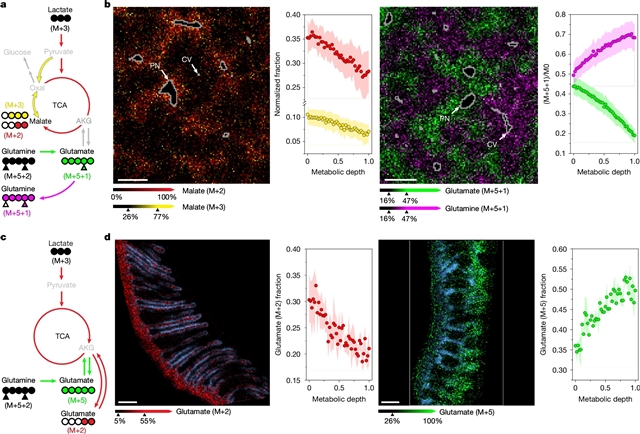研究提出肝脏和小肠的空间代谢梯度

普林斯顿大学Joshua D. Rabinowitz小组近日取得一项新成果。经过不懈努力,他们提出了肝脏和小肠的空间代谢梯度。2025年10月15日出版的《自然》发表了这项成果。
在这里,该课题组绘制了肝脏和肠道的空间代谢梯度。研究组开发了一个集成的实验计算工作流程,主题是矩阵辅助激光解吸/电离(MALDI)成像质谱(IMS),同位素示踪和深度学习人工智能。大多数代谢物(90%)在肝小叶和肠绒毛中显示出显著的空间浓度梯度。在肝脏中,三羧酸(TCA)循环代谢物及其同位素标记来自谷氨酰胺和乳酸的定位。能量应激代谢物,包括单磷酸腺苷(AMP),也定位于门静脉周围,与门静脉周围高能量需求一致。在肠道中,TCA中间体苹果酸盐(顶端)和柠檬酸盐(隐窝)呈现相反的空间模式,根据同位素示踪,这与尖端较高的谷氨酰胺分解代谢和隐窝较高的乳酸氧化一致。
最后,该团队绘制了致肥性膳食糖果糖的命运图。在肠道中,口服果糖在绒毛底部的分解代谢比在绒毛顶端的分解代谢快。在肝脏中,果糖衍生的碳以果糖-1-磷酸的形式在中心周围积聚,并引发中心周围三磷酸腺苷(ATP)耗竭。他们都提供了关于肠道和肝脏代谢组织的基础知识,并确定了果糖诱导的肝脏代谢局灶性紊乱。
研究人员表示,哺乳动物细胞的特性取决于它们在器官中的位置。肝脏中的基因表达在门静脉周围和中央周围肝细胞之间存在差异,而在肠中,从隐窝到绒毛细胞的表达也存在差异。组织空间组织的一个关键因素可能是代谢,但对空间代谢的直接评估仍然有限。
附:英文原文
Title: Spatial metabolic gradients in the liver and small intestine
Author: Samarah, Laith Z., Zheng, Clover, Xing, Xi, Lee, Won Dong, Afriat, Amichay, Chitra, Uthsav, MacArthur, Michael R., Lu, Wenyun, Jankowski, Connor S. R., Ma, Cong, Hunter, Craig J., Neinast, Michael, Weilandt, Daniel R., Raphael, Benjamin J., Rabinowitz, Joshua D.
Issue&Volume: 2025-10-15
Abstract: The properties of mammalian cells depend on their location within organs. Gene expression in the liver varies between periportal and pericentral hepatocytes1,2,3, and in the intestine from crypts to villus tips4,5. A key element of tissue spatial organization is probably metabolic, but direct assessments of spatial metabolism remain limited. Here we map spatial metabolic gradients in the mouse liver and intestine. We develop an integrated experimental–computational workflow using matrix-assisted laser desorption/ionization (MALDI) imaging mass spectrometry (IMS), isotope tracing and deep-learning artificial intelligence. Most measured metabolites (>90%) showed significant spatial concentration gradients in the liver lobules and intestinal villi. In the liver, tricarboxylic acid (TCA)-cycle metabolites and their isotope labelling from both glutamine and lactate localized periportally. Energy-stress metabolites, including adenosine monophosphate (AMP), also localized periportally, consistent with a high periportal energy demand. In the intestine, the TCA intermediates malate (tip) and citrate (crypt) showed opposite spatial patterns, aligning with higher glutamine catabolism in tips and lactate oxidation in crypts based on isotope tracing. Finally, we mapped the fate of the obesogenic dietary sugar fructose. In the intestine, oral fructose was catabolized faster in the villus bottom than in the tips. In the liver, fructose-derived carbon accumulated pericentrally as fructose-1-phosphate and triggered pericentral adenosine triphosphate (ATP) depletion. Thus, we both provide foundational knowledge regarding intestine and liver metabolic organization and identify fructose-induced focal derangements in liver metabolism.
DOI: 10.1038/s41586-025-09616-5
Source: https://www.nature.com/articles/s41586-025-09616-5



